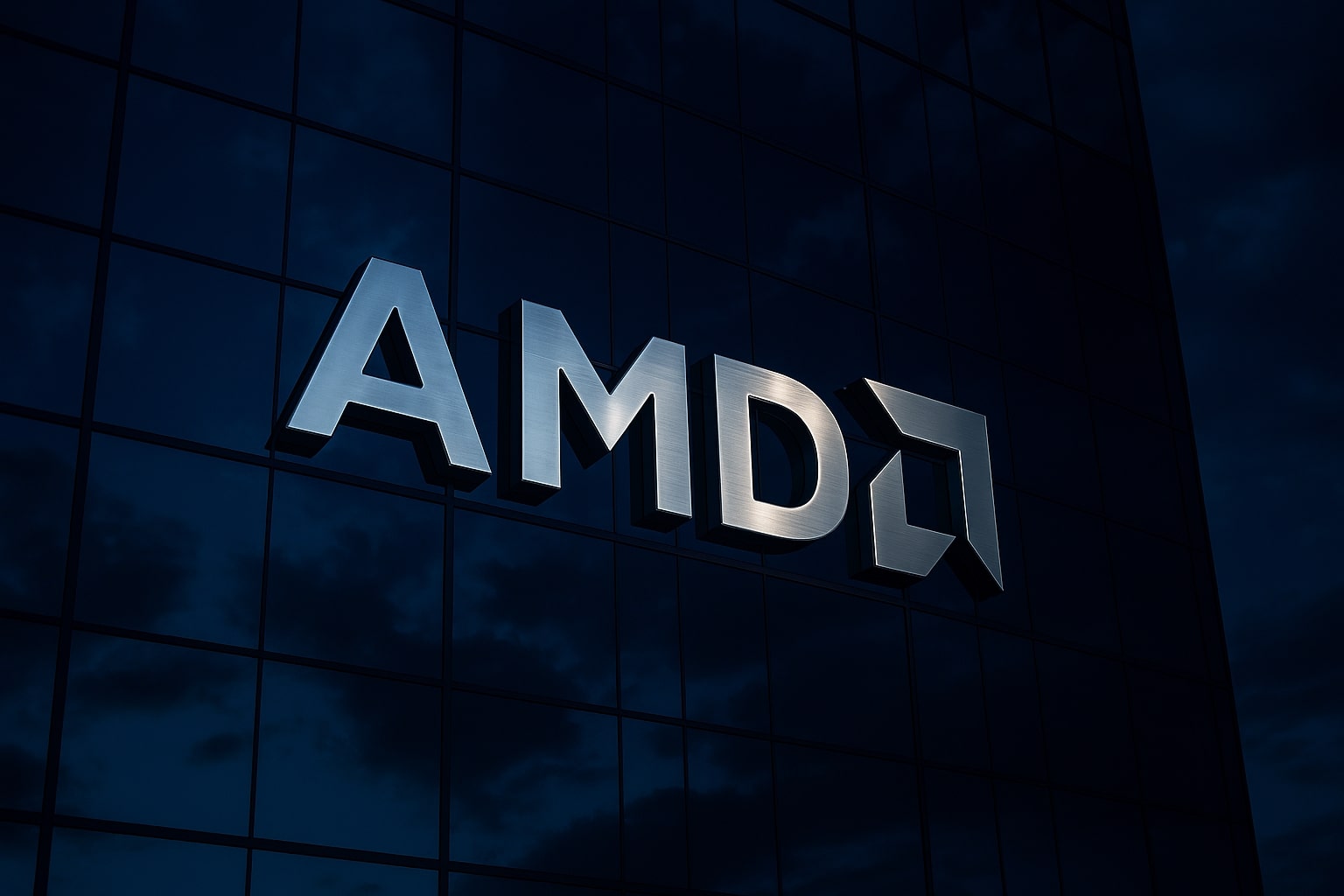
AMD Stock Price Forecast - AMD Powers Toward $1 Trillion Valuation as Data Center Drive Record $9.2B Quarter
AMD’s Q3 revenue soared 36% YoY to $9.2B with EPS at $0.75 and Data Center sales hitting $4.34B | That's TradingNEWS
Advanced Micro Devices (NASDAQ:AMD) Targets $1 Trillion Market Cap as AI, Data Center, and Client Segments Surge
Real-Time Chart for NASDAQ:AMD
Unprecedented Q3 Surge Confirms AMD’s Structural Strength
Advanced Micro Devices (NASDAQ:AMD) delivered its strongest quarter on record with revenue climbing to $9.2 billion, up 36% year-over-year and 20% quarter-over-quarter, driven by accelerating demand in AI, data center, server, and client markets.
Gross margin held at 52%, slightly above last year’s 50%, while operating income doubled to $1.3 billion, reflecting expanding profitability despite elevated R&D investment.
GAAP earnings per share rose to $0.75, a sharp increase from $0.47 a year earlier.
This performance came without any contribution from MI308 GPU shipments to China, after export restrictions halted those deliveries in mid-year. The company absorbed that hit with a prior $800 million inventory charge, yet maintained growth momentum—proof that AMD’s core business remains fundamentally healthy and no longer dependent on a single geography.
Data Center Momentum and AI Ramp Reshape AMD’s Growth Curve
The Data Center segment, now AMD’s revenue anchor, climbed to $4.34 billion in Q3 2025, up 22.5% year-over-year and 33.9% sequentially.
The margin compressed modestly from 29% to 25%, but total operating income still increased, reflecting a temporary efficiency cost from scaling production of the MI350 and EPYC Turin CPUs for hyperscalers.
AMD’s partnership with OpenAI (OPENAI) positions the company as a critical supplier in the next-generation compute buildout. The two companies inked a 6 gigawatt deployment agreement, with the first 1 GW slated for rollout in the second half of 2026. The deal includes up to 160 million AMD common shares in warrants to OpenAI—structured to vest as infrastructure milestones are met—aligning incentives directly with AI capacity growth.
AMD expects these deployments, alongside Oracle’s (NYSE:ORCL) hyperscale clusters, to generate over $100 billion in cumulative AI data-center revenue through 2030. The latest GPU release, MI350X, already achieved 4.6× higher inference throughput and 3× training performance over its predecessor, narrowing the software performance gap versus Nvidia (NASDAQ:NVDA) while offering 15-40% lower total cost of ownership for enterprise customers.
x86 Dominance Expands as Intel Falters
AMD’s x86 CPU market share reached 30.9% in Q3 2025, up 5.9 points year-over-year, setting records in both desktop and server categories.
Client revenue jumped to $2.75 billion (+46%), and Gaming revenue to $1.29 billion (+180%), driven by Ryzen-powered notebooks, console chip demand from Sony (NYSE:SONY) and Microsoft (NASDAQ:MSFT), and a corporate PC refresh cycle tied to the end-of-support for Windows 10 in October 2025.
While Intel (NASDAQ:INTC) struggles with ongoing capacity constraints on its 10 nm and 7 nm lines, AMD capitalized, gaining share in both server and desktop markets.
Operating margins in Client and Gaming rose from 12% to 21%, underlining the profitability of AMD’s product mix and efficient scaling of its Ryzen, Radeon, and Threadripper lines.
AI Infrastructure and Product Roadmap Anchor the Next Phase
At its Analyst Day 2025, AMD unveiled a roadmap that targets compound annual revenue growth of 35% and non-GAAP EPS of $20 by 2030, with Data Center revenue projected to exceed $100 billion annually.
The growth engine rests on an integrated AI stack across MI350, MI450, and MI500 GPUs, and the Helios rack-scale architecture, combining CPUs, GPUs, networking, and cooling into unified AI systems.
The MI350 series became the fastest-ramping product in company history, while the MI450 will debut in Q3 2026, followed by MI500 in 2027. Seven of the world’s ten largest AI companies are already deploying AMD Instinct accelerators, validating the maturity of its ROCm 7 software platform, whose downloads surged tenfold year-over-year.
The CPU roadmap complements that trajectory: Zen 6, built on TSMC 2 nm, and Zen 7, designed with extended AI data pipelines, ensure AMD maintains architectural leadership through the end of the decade.
Financial Strength, Balance Sheet, and Buyback Capacity
AMD’s balance sheet remains exceptionally strong, with $7.24 billion in cash and equivalents and $3.22 billion in debt, leaving a net cash position of $4 billion.
Inventory increased to $7.31 billion, reflecting strategic buildup for MI300-series deployments and new custom semiconductor contracts totaling $45 billion across aerospace, automotive, and communications verticals.
The company maintains a $6 billion share-repurchase authorization, signaling continued confidence in free-cash-flow growth
Read More
-
Apple Stock Price Forecast - AAPL Shares Climbs to $270.87 After Record Quarter but Faces Growth Fatigue
21.11.2025 · TradingNEWS ArchiveStocks
-
XRP ETFs Crash as Whale Sell-Offs Slam XRP-USD Below $2 — XRPI and XRPR Face $411M in ETF Flows and Heavy Volatility
21.11.2025 · TradingNEWS ArchiveCrypto
-
Natural Gas Price (NG=F) Climbs to $4.62 as Winter Demand and Record LNG Exports Fuel Bullish Momentum
21.11.2025 · TradingNEWS ArchiveCommodities
-
Stock Market Today - Dow Climbs to 46,300 as NVDA, LLY, GAP, WMT Drive Market Rally
21.11.2025 · TradingNEWS ArchiveMarkets
-
USD/JPY Price Forecast - Dollar to Yen Steadies Above 156 After Intervention Threats
21.11.2025 · TradingNEWS ArchiveForex
Valuation Context: Stretch or Strategic Premium?
At $247 per share (November 21 2025 close), AMD trades at a forward non-GAAP P/E of 62×, above its 5-year average of 38× but still justified by projected EPS CAGR of 42.8% and revenue CAGR of 35% through 2029.
This implies a 4-year PEG ratio of 1.45×, roughly in line with peers like Nvidia (1.34×) and Broadcom (1.48×), and significantly above Intel (0.12×), reflecting AMD’s superior earnings scalability.
If AMD meets its earnings goal of $20 EPS, it could achieve a market capitalization approaching $1.2 trillion, rivaling AVGO’s $1.67 trillion and edging into the Trillion-Dollar Club.
Its long-term bull-case valuation reaches $771 per share, assuming consistent margin execution and full data-center ramp.
Options, Liquidity, and Institutional Positioning
Market-maker gamma exposure (GEX) shows net long positioning, implying dealers are likely to buy dips and stabilize volatility near $260, the immediate resistance zone. A breakout could accelerate momentum toward $300, where open interest and delta exposure concentrate.
Dark-pool data since late October show intermittent profit-taking but no structural exit from institutional holders. The 5-day DIX trend remains near neutral, suggesting potential re-entry once macro volatility moderates.
Risks: Execution, Regulation, and Supply Dependence
AMD’s growth path relies on perfect synchronization of product rollouts and manufacturing yield.
Any delay in MI450 or Helios rack deployment could shift revenue recognition by quarters.
Geopolitical risk remains acute: the GAIN AI Act, proposed in Washington, could restrict GPU exports to China, threatening near-term revenue diversity.
AMD’s dependence on TSMC’s CoWoS packaging and substrate supply also adds potential capacity bottlenecks precisely as demand peaks.
Strategic Outlook and Verdict
AMD’s Q3 results and forward guidance show a company evolving from a cyclical chipmaker into a systemic AI infrastructure player.
With Data Center and Client segments compounding at double-digit rates, AI design wins exceeding $50 billion, and a balance sheet positioned for scale, AMD demonstrates structural resilience and execution strength unmatched in its peer group except for Nvidia.
Given the underlying numbers, roadmap visibility, and institutional flow patterns, NASDAQ:AMD is rated a Strong Buy.
At current levels around $247, the risk/reward profile favors accumulation ahead of Q4 guidance and 2026 AI infrastructure ramp.
Upside potential extends toward $300-$350 near-term, with long-term valuation north of $700 if EPS and data-center targets materialize.



















